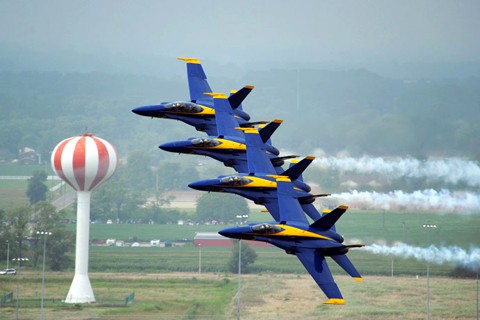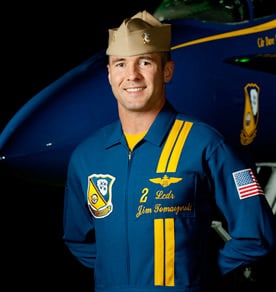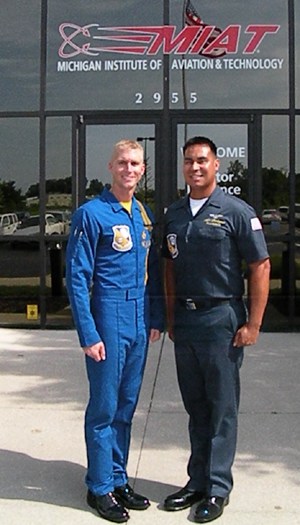
The Navy Blue Angels high performance flight team was the highlight at the Willow Run-Thunder Over Michigan air show this past week-end. Operated by the Yankee Air Museum located at the Willow Run Airport in western Wayne County, the air show was fortunate by having the Blue Angels as the main attraction. Thousands were in attendance watching the intricate maneuvers with awe and amazement.
Some of the intricate Blue Angel maneuvers have the planes only 18 inches apart. As part of the air show, vintage World War II planes reenacted a South Pacific dogfight between Corsairs and Zeros.

Part of the mission statement for the Blue Angels is public relations and outreach. The Blue Angels team is empowered to credibly represent Navy and Marine Corps aviation and enhance recruiting. They are the consummate ambassadors of team work and good will.
Blue Angel pilot, Lt. C.J. Simonsen and Airman Issac Dominguez spoke at the Michigan Institute of Aviation and Technology in connection with the team’s appearance at Thunder Over Michigan. According to Charles Hawes, President of MIAT, the visit provided an up-close and personalized experience for the students and visitors. Hawes added, “This was the third time we have hosted the Blue Angels and we hope to do it again.” The event was in the state-of-the-art MIAT hanger at their Canton, MI facility and over 500 attended.
Simonsen and Dominguez, who is a specialized aviation mechanic, spoke to the group about all aspects of the Navy Flight Demonstration Squadron including power plant maintenance for the aircraft. “Nothing moves until the mechanics sign off,” said the ever smiling Dominguez.
Originally from Odessa, Texas, Dominguez spoke about his three-year tour commitment with the squadron. “The team consists of seven distinct departments, jointly responsible for guaranteeing readiness. We do a lot of cross utilization, so training is key,” he added. A tribute to this dedicated team approach is that the Blue Angels have never canceled an air show due to a maintenance problem.

Tomaszeski is the second plane on the right side during the precision flying of the F/A-18 Hornet squadron. He is a Florida State graduate and is steeped in the long tradition of the Navy and Marines as his father was an Admiral.
Tomaszeski had completed several Western Pacific Group deployments aboard the USS Kitty Hawk before joining the Blue Angels in September of 2009. He has accumulated more than 2,000 flight hours and has 271 carrier arrested landings.
The Blue Angels had a change of command recently and Capt. Greg McWherter is in his second tour as the Blue Angels’ Commanding Officer. The Chief of Naval Air Training selects the ‘Boss’. The C.O. or ‘Boss’ must have at least 3,000 tactical jets flight-hours and have commanded a tactical jet squadron. It is not a desk job by any means as the Commanding Officer flies the Number 1 jet for the Blue Angels.
The Blue Angels will be in Seattle, Washington, August 6-7, for SEAFAIR-2011 and Fleet Week celebrations. They will perform over Lake Washington. The annual festivities take on an added significance as this is the Centennial of Naval Aviation which will honor aviation-related achievements and a century of mission-ready men and women in the Navy, Marines and Coast Guard.

Chicago Air and Water Show to Feature Multiple Aviation Disciplines
The Navy will also have a presence at the annual Chicago Air and Water Show, August 20-21, at North Avenue Beach. The free event is expected to have giant crowds and can be accessed from North Lake Shore Drive in Lincoln Park.
The precision parachute team, Leap Frogs will be featured. A typical Leap Frogs performance consists of fourteen jumpers leaping out of an aircraft at an altitude of 12,500 feet. During free fall, jumpers reach speeds of 120 mph and can accelerate up to 180 mph by pulling their arms to their sides and straightening their legs into what is called a “track.”
The jumpers typically open their parachutes at around 5,000 feet by releasing a smaller pilot chute which deploys their main blue-and-gold canopy. After deploying their chutes, the Leap Frogs fly their canopies together to build dramatic visual formations.
http://www.blueangels.navy.mil/
Lt. C.J. Simonson and Airman-D2 Issac Dominguez of the Blue Angels spoke at the Michigan Institute of Aviation and Technology in Canton, Michigan recently. It was a full house with spirited questions for the two Naval aviation ambassadors.
